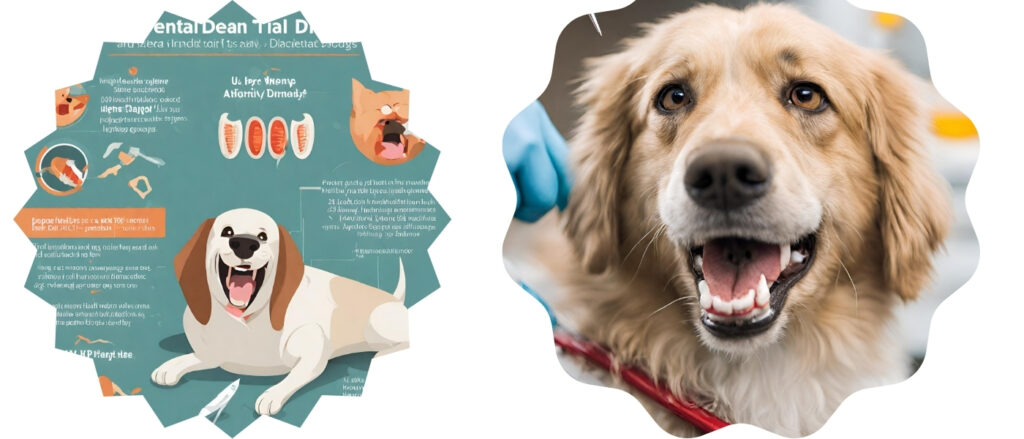Wow! Let’s explore the top 10 common diseases in dog and how to prevent them. Early detection can keep your furry friend healthy and save you money on vet bills.
Contents
1. DENTAL DISEASES

The first common disease in dogs is dental disease. Dogs often get oral infections like gingivitis and tartar after age three. These lead to dental diseases. Watch for symptoms. They include trouble eating hard food and bad breath. Staying on top of your dog’s oral care can help prevent situations like this from occurring. Regular vet visits for teeth cleaning can help prevent dental disease. Sometimes dog grooming organizations will also include teeth cleaning in their regular packages.
2. EAR INFECTIONS
If you notice that your dog scratches at their ears a lot. Or if they tip or shake their head. You should get their ears checked for an infection. Other indicators can be loss of fur, odor, and redness or swelling of the ear canal. If ear infections are reoccurring, there is also the potential for allergy involvement. To prevent ear infections, dry your dogs’ ears after they swim. Use a cleaning solution to clean their ears. Manage any allergies they have.
3. ITCHY SKIN OR SKIN INFECTIONS
Normal scratching is occasional. Dogs do it. But, continual scratching can be a sign of a skin condition, infection, or allergy. Certain food items such as soy, wheat, and corn can cause skin allergies in some dogs. Other causes can be bacterial or yeast infections. They can cause Hot Spots or painful sores. Your veterinarian can treat these conditions. They do so with antibiotics, diet changes, or specialized shampoo. These treatments help with the skin issues.
4. STIFFNESS AND PAIN
As dogs age, they get arthritis and joint pain. This is especially true if they also gain too much weight. Other causes of joint stiffness and pain can be overexertion. They can also be bacterial encephalitis or parasitic infestations. A few signs of inflammation and stiffness are awkward gaits and reluctance to rise. Limb rigidity, swelling, muscle spasms, depression, or fatigue are also signs. Treatment depends on the conditions identified by your veterinary provider.
5. KENNEL COUGH OR CANINE COUGH
This common name is for a range of respiratory infections. They can be bacterial or viral and impact the windpipe and/or voice box. The two main causes are the bacterium Bordetella bronchiseptica and canine parainfluenza virus. Kennel Cough gets its name from a respiratory infection. It spreads quickly. It does so in enclosed places with little air circulation, like a kennel or shelter. These infections can travel through shared air, water, or objects. You can often identify a lung disease from a dry cough, gagging sound, fever, or coughing up white foam. One way to prevent contractions is to keep your dog’s vaccinations up to date. To treat these lung conditions, consult your vet. Keep your pet isolated from other animals to stop spreading.
6. OBESITY
Managing a dog’s weight can be tricky. This is because many dog owners struggle to tell when their pet is overweight. That is why this health issue can be one of the most overlooked dangers to pet longevity. This is often because obesity can lead to many health problems. These include high blood pressure and kidney, liver, or thyroid issues. Also, arthritis, diabetes, and cancer.

7. RINGWORM
Contrary to its name, ringworm is a contagious fungus that can infect the skin, hair, and nails. In dogs, it can also lead to patches of hair loss. Ringworm unfortunately can also spread from a canine to a human . This condition creates circular red spots that help identify it. Skin lesions often appear on the head, ears, paws, and forelimbs. Even dogs without symptoms can carry this illness. Young or malnourished dogs are more at risk of contracting ringworm. A professional should determine treatment based on the severity of the infection.
8. HEARTWORM
The title of this disease is unfortunate. It does describe a worm that lives in the heart and arteries of infected animals. Heartworm is an illness transmitted from one animal to another by mosquitoes. Perform blood testing to screen for heartworm. These parasites travel through the bloodstream, harming arteries and organs. They usually spread after six months to the heart and lungs. Symptoms can be weight loss, fatigue, labored breathing, coughing, or vomiting. Or, there may be no symptoms at all. This condition is preventable with cheap medication. But, if left untreated, it can be fatal.
9. DIABETES
Like people, dogs can develop Type I and Type 2 diabetes. They face some of the same complexities that we do. The most common form of the disease in dogs is Type I. It requires them to get insulin to survive. This occurs when a dog’s pancreas cannot produce enough insulin on its own for its body to function. Signs that your dog could have diabetes are: excessive thirst and weight loss. Their breath might carry a hint of sweetness or fruitiness. It’s accompanied by the dull haze of cataracts. And, by the torment of skin or urinary tract infections. Their energy ebbs, surrendering to lethargy. Some breeds are also more susceptible than others to having these conditions. Treating diabetes is very personal. So, you need to work with a vet who understands the condition well. This is important for keeping your dog healthy.
10. CANCER
Standing at the 10th position among the most common diseases in dogs is Cancer. About 65 million dogs live in the United States. Each year, about 6 million of them get cancer. Cancer is not always fatal. But, it can be one of the hardest conditions to identify. Once confirmed, though, vets use many of the same treatment options for dogs as for people. For example, chemotherapy, radiation therapy, and surgery. Many types of cancers can impact dogs. Some are very treatable, but others are not.
Dogs can have various health conditions. Each breed and region has its own set of common problems and vulnerabilities.
To keep your dog healthy, it’s essential to check their health status. Protect and care for them as much as possible. To prevent some diseases, you can give them certain functional foods. These foods help the health of these little companions.











